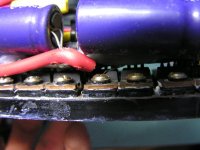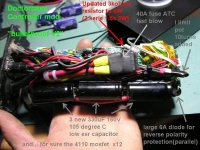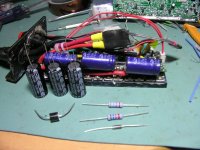Doctorbass
100 GW
I blown my controller again  . .....hmmmmm....
. .....hmmmmm....  third time.... i think i abuse it a bit too much! :lol:
third time.... i think i abuse it a bit too much! :lol:
Yess... Am I the first to proove that the 4110 aren't bulletproof ?
Today, on my dinner break, i decided to go on the little forest close to my job building and to have fun, riding in the sand, and climbing hill... eee... I MEAN HILL .. and ... ... it died... no throttle, no C-A display...
.. and ... ... it died... no throttle, no C-A display... 
I know that the first time i blown my controller, i installed a 40A fuse inside.. so since i increased the current limit to 75A, maybe with long extended high power demand it blown.. but.. i wasen't lucky... that was not only the fuse... :lol:
from now, just after i opened the box, i located one visible mosfet that exploded..... i guess that they blow in pair or quad.. so i will replace them.. i have some spare! :wink:
i just hope the IR2101 gate driver did not blown too....
I was surprized to find about 1 ox of sand inside!!!!! curious, because i completly sealed it!! last time i opened it :|
curious, because i completly sealed it!! last time i opened it :|
like usual, here are some pics
Yess... Am I the first to proove that the 4110 aren't bulletproof ?
Today, on my dinner break, i decided to go on the little forest close to my job building and to have fun, riding in the sand, and climbing hill... eee... I MEAN HILL
I know that the first time i blown my controller, i installed a 40A fuse inside.. so since i increased the current limit to 75A, maybe with long extended high power demand it blown.. but.. i wasen't lucky... that was not only the fuse... :lol:
from now, just after i opened the box, i located one visible mosfet that exploded..... i guess that they blow in pair or quad.. so i will replace them.. i have some spare! :wink:
i just hope the IR2101 gate driver did not blown too....
I was surprized to find about 1 ox of sand inside!!!!!
like usual, here are some pics







